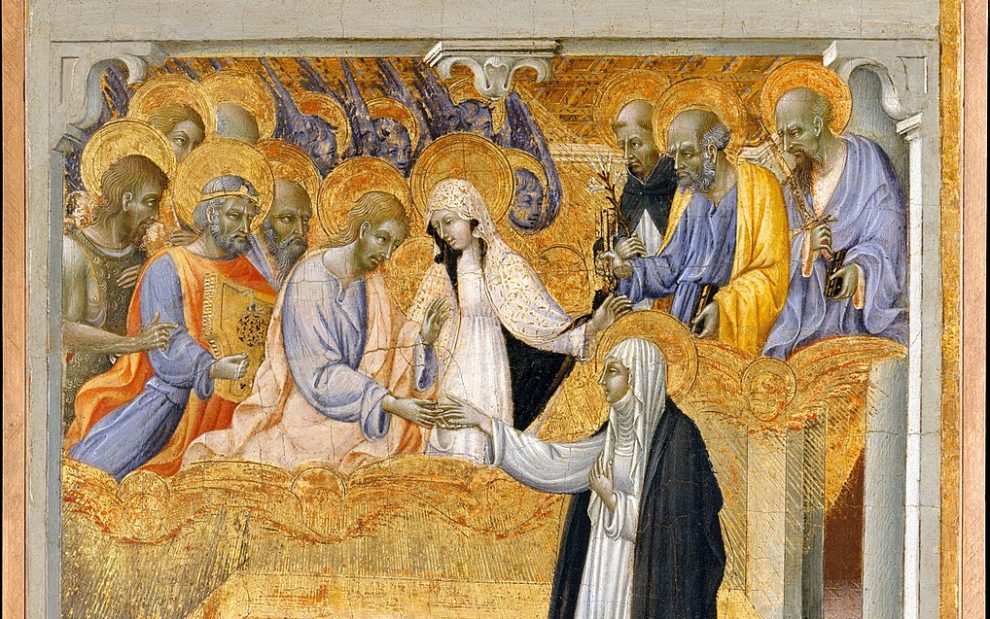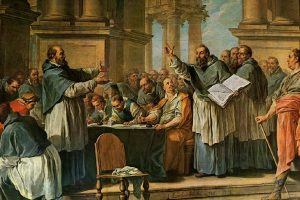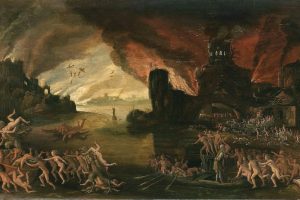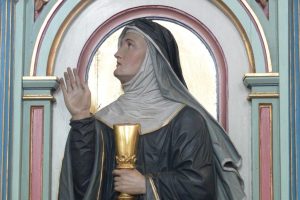What does it mean to be a “doctor of the church”? Who has been designated this title and why? Who are the doctors of the church?
A doctor of the church is a person whose teaching on faith has been deemed sound and of benefit to the church through their writing, study, or research. Along with significant theological contribution, the person must also display a high degree of sanctity, which is why all church doctors are also canonized saints. A third requirement to be named a doctor of the church is formal proclamation as such by the pope or an ecumenical council.
The first church doctors were declared by Pope Boniface VIII in the 13th century: Sts. Ambrose, Jerome, Augustine, and Pope Gregory the Great. The first women to be named as church doctors were Sts. Teresa of Ávila and Catherine of Siena in 1970 by Pope Paul VI.
The following is a list of all the doctors of the church in the order of when they were designated (the year given in brackets at the end of each entry).
Saint Ambrose (c. 340-397)
Bishop of Milan, Italy, a major opponent of Arianism, wrote and preached extensively [named a Doctor of the church, 1298].
Saint Augustine of Hippo (c. 354-430)
(North African bishop, author of Confessions, City of God, and numerous treatises, countered heretical movements, one of the most influential theologians of the Western church, called “Doctor of Grace” [1298].
Saint Jerome (c. 343-420)
Translated Old Testament from Hebrew into Latin and revised Latin translation of New Testament to produce Vulgate version of Bible, called “Father of Biblical Science” [1298].
Saint Gregory the Great (c. 540-604)
Pope, strengthened papacy and worked for clerical and monastic reform [1298].
Saint Athanasius (c. 297-373)
Bishop of Alexandria, dominant opponent of Arians, called “Father of Orthodoxy” [1298]
Saint John Chrysostom (“Golden-Mouthed”) (c. 347-407)
Archbishop of Constantinople, homilist, writer of scripture commentaries and letters, patron of preachers [1568].
Saint Basil the Great (c. 329-379)
Bishop of Caesarea in Asia Minor, refuted Arian errors, wrote treatises, homilies, and monastic rules, called “Father of Monasticism of the East” [1568].
Saint Gregory of Nazianzus (c. 330-390)
Bishop of Constantinople, opponent of Arianism, wrote major theological treatises as well as letters and poetry, called the “Christian Demosthenes” and, in the East, “The Theologian” [1568].
Saint Thomas Aquinas (1225-1274)
Italian Dominican, wrote systematically on philosophy, theology, and Catholic doctrine, patron of Catholic schools and education, one of the most influential theologians in the West [1568].
Saint Bonaventure (c. 1217-1274)
Franciscan, bishop of Albano, Italy, cardinal [1588].
Saint Anselm of Canterbury (1033-1109)
Archbishop, called “Father of Scholasticism” [1720].
Saint Isidore of Seville (c. 560-636)
Spanish bishop, encylopedist, and preeminent scholar of his day [1722].
Saint Peter Chrysologus (c. 400-450)
Archbishop of Ravenna, Italy, homilist and writer, counteracted Monophysite heresy [1729].
Saint Leo I, the Great (c. 400-461)
Pope, wrote christological and other works against the heresies of his day [1754].
Saint Peter Damian (1007-1072)
Italian Benedictine and cardinal, ecclesiastical and clerical reformer [1828].
Saint Bernard of Clairvaux (c. 1090-1153)
French Cistercian abbot and monastic reformer, called “Mellifluous Doctor” [1830].
Saint Hilary of Poitiers (c. 315-368)
One of first Latin doctrinal writers, opposed Arianism [1851].
Saint Alphonsus Liguori (1696-1787)
Founder of Redemptorists, preeminent moral theologian and apologist, patron of confessors and moralists[1871].
Saint Francis de Sales (1567-1622)
Bishop of Geneva, spiritual writer, patron of Catholic writers and press [1877].
Saint Cyril of Alexandria (c. 376-444)
Bishop, authored doctrinal treatises against Nestorian heresy [1882].
Saint Cyril of Jerusalem (c. 315-386)
Bishop, catechist, vigorous opponent of Arianism [1882].
Saint John Damascene (c. 675-749)
Syrian monk, doctrinal writer, called “Golden Speaker” [1890].
Saint Bede the Venerable (c. 673-735)
English Benedictine, called “Father of English History” [1899].
Saint Ephrem the Syrian (c. 306-373)
Counteracted Gnosticism and Arianism with his poems, hymns, and other writings [1920].
Saint Peter Canisius (1521-1597)
Dutch Jesuit, catechist, important figure in Counter-Reformation in Germany [1925].
Saint John of the Cross (1542-1591)
Founder of Discalced Carmelites, called “Doctor of Mystical Theology” [1926].
Saint Robert Bellarmine (1542-1621)
Italian Jesuit, archbishop of Capua, wrote Reformation-era doctrinal defenses, catechisms, and works on ecclesiology and church-state relations [1931].
Saint Albert the Great (c. 1200-1280)
German Dominican, bishop of Regensburg, teacher of Saint Thomas Aquinas, patron of scientists, called “Universal Doctor” and “Expert Doctor” [1932].
Saint Anthony of Padua (1195-1231)
First theologian of Franciscans, preacher, called “Evangelical Doctor” [1946].
Saint Lawrence of Brindisi (1559-1619)
Italian Capuchin Franciscan, influential post-Reformation preacher [1959].
Saint Teresa of Ávila (1515-1582)
Spanish Carmelite, initiated discalced Carmelite movement, prolific spiritual and mystical writer, first woman Doctor of the church [1970].
Saint Catherine of Siena (c. 1347-1380)
Italian Third Order Dominican, mystical author, also active in support of Crusades and in papal politics [1970].
Saint Thérèse of Lisieux (1873-1897)
French Carmelite, wrote spiritual autobiography describing her “little way” of spiritual perfection [1997].
Saint John of Ávila (1499 or 1500-1569)
Spanish priest, preacher, and mystic, was influential in spreading the faith in Andalusia and reforming the church in Spain [2012]
Saint Hildegard of Bingen (1098-1179)
German Benedictine abbess and mystic, recorded her visions in writing, also wrote lyric poems, letters of advice and prophecy, and treatises on medicine and physiology [2012]
Saint Gregory of Narek (c. 950-1005)
Armenian monk and poet, also recognized as a saint in the Armenian Apostolic Church [2015]
Saint Irenaeus (c. 125-202)
Greek bishop, originally from Smyrna, known for defending Christian teaching against gnostic sects, for introducing the three pillars of orthodoxy, and being the first to declare the four canonical gospels essential [2022]
Saint John Henry Newman (1801-1890)
English theologian and cardinal of the church, an Anglican priest before his conversion to Catholicism, known for his philosophical writings, sermons, and poetry as well as for his theology and apologetics [2025].
Image: Wikimedia/Giovani di Paolo, The Mystic Marriage of St. Catherine of Siena, c. 1460













Add comment